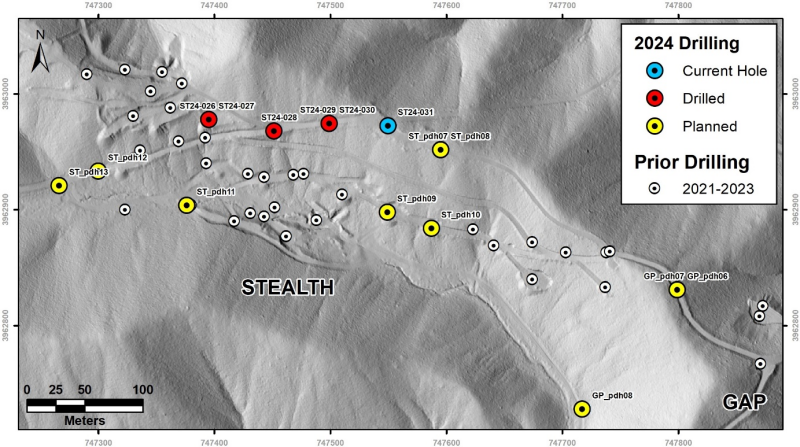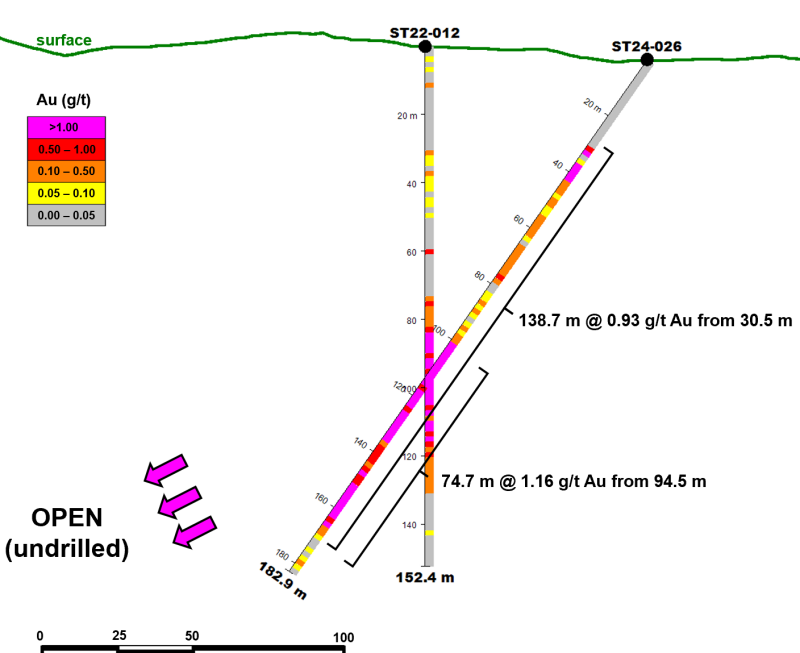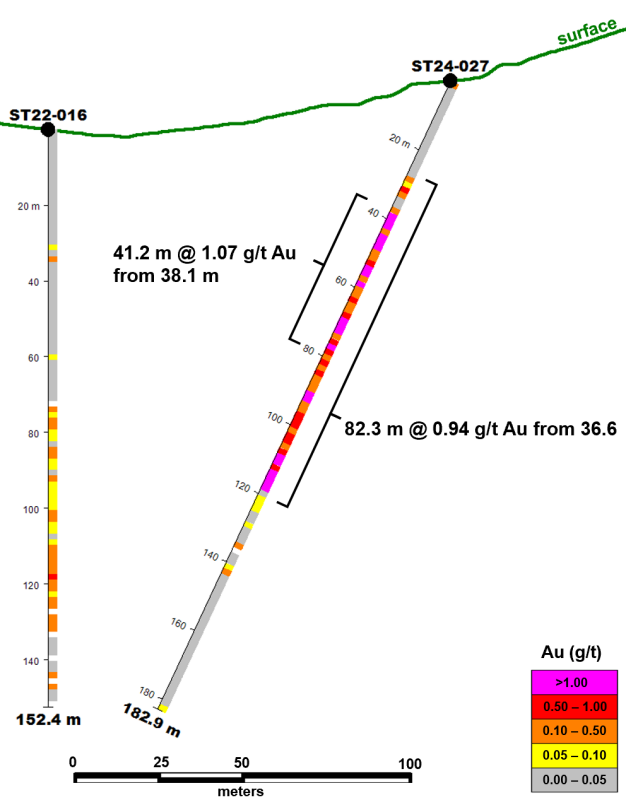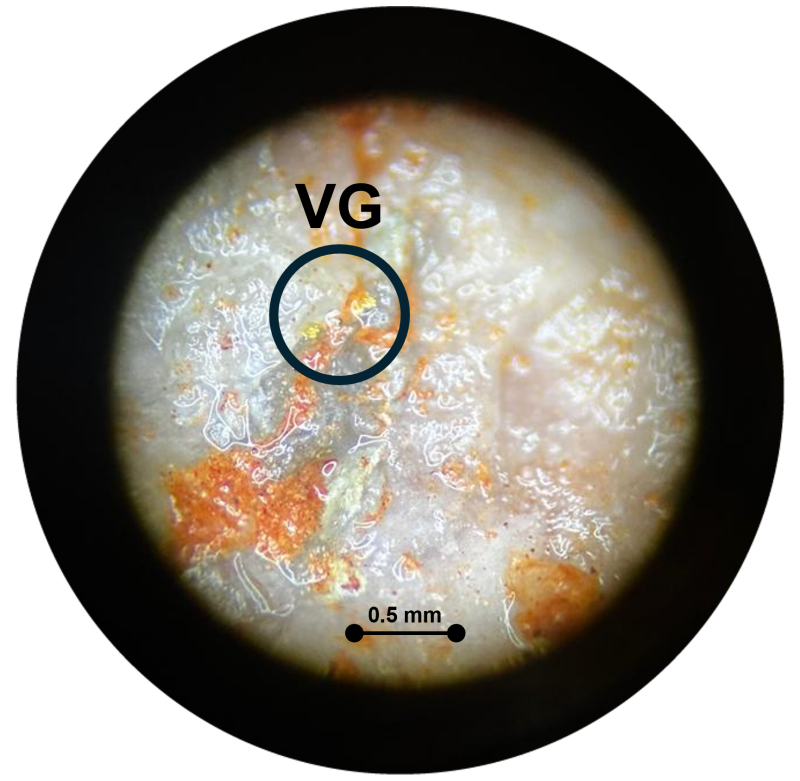ORIGINAL: Gold Basin Reports Broad High-Grade Shallow Oxide Gold Intercepts From First Two Resource Expansion Drill Holes, Multiple Visible Gold Occurrences Identified in RC Chip Trays
2024-07-10 07:30 ET - News Release
(via TheNewswire)
138.7 M @ 0.93 G/T AU FROM 30.5 M, INCL. 74.7 M @ 1.16 G/T AU FROM 94.5 M
82.3 M @ 0.94 G/T AU FROM 36.6 M, INCL. 41.2 M @ 1.07 G/T AU FROM 38.1 M
July 10, 2024 – TheNewswire – Vancouver, British Columbia: Gold Basin Resources Corporation (the "Company" or "Gold Basin") – (TSX-V GXX, OTCQB: GXXFF) today announced assay results for the first two reverse-circulation (“RC”) drill holes from the Company’s ongoing resource expansion and delineation drill campaign at the Company's 100%-owned Gold Basin oxide gold project in northwestern Arizona (the "Gold Basin Project " or the "Project ").
Highlights:
-
Both drill holes produced broad, near-surface, high-grade oxide gold intercepts at the Stealth Deposit (“Stealth”):
-
Multiple 0.25 to 0.50 millimeter (“mm”) occurrences of visible gold (“VG”) identified in RC chip trays;
-
As shown by previous drilling, the system remains in oxide from surface through the deepest gold intercept to date;
-
Both holes collared into Quaternary-Tertiary gravel cover before entering thick mineralized sequences, demonstrating the potential for significant mineralized systems hidden under shallow cover along the ~10-kilometer-long Stealth and Cyclopic gold trends;
-
Five holes totaling 1,027 m have been completed out of the planned 3000 m program, with the next batch of results anticipated in three weeks.
Colin Smith, Chief Executive Officer of the Company, commented: “Assay results from resource expansion drilling at Stealth are on par with some of the best oxide gold results to date at the Project and showcase the robust nature of the Stealth oxide gold system. In particular, the result from drill hole ST24-026 is highly encouraging, as it confirms the extension of a high-grade oxide gold plunge at depth, which remains open, and is to be further tested in this drill program.”
Q2 2024 Drill Program Update
Drilling has commenced from west to east along a road running subparallel to and north of the Stealth oxide gold deposit (Figure 1). This road hosts only one historical drill hole, and offers an excellent opportunity to extend the mineralized envelope in breadth, down-dip, and along plunge.
Five drill holes have been completed to date (ST24-026 to ST24-030) and ST24-031 is ongoing, with a total production of 1027 meters. The remaining eight holes at Stealth will be drilled in planned sequence, before the rig mobilizes to the Gap Zone for the program’s final eight holes.
Drill Hole ST24-026
Lithologic observations from drill hole ST24-026, which noted multiple 0.25 to 0.50 mm visible gold occurrences in the RC chips, are consistent with assay results announced above and are strongly supported by field observations, with gold mineralization first occurring immediately below known Quaternary-Tertiary gravels at 30.5 meters (Table 1, Figure 2, Figure 4). Gold mineralization is coincident with pervasive hematitic staining, especially where visible gold is observed. At least three basement stratigraphic units are present in ST24-026, a relation consistent with local field relations.
Drill Hole ST24-027
As with drill hole ST24-026, lithologic observations from ST24-027 are in concert with the assay results presented herein and local field mapping interpretations. Gold mineralization occurs below Quaternary-Tertiary gravels at a depth of 36.6 meters and continues to 82.3 meters (Table 1, Figure 3). All three basement stratigraphic units are oxidized, with notable zones of hematitic staining coincident with gold mineralization in the assay data. The relationship between basement stratigraphic units amongst drill holes is ongoing.
Table 1: Drill hole intersections from ST24-026 and ST24-027.
| Target | Drill Hole | From (m) | To (m) | Intersection (m) | Au (g/t) |
| Stealth | ST24-026 | 30.5 | 169.2 | 138.7 | 0.93 |
| Stealth | incl. | 36.6 | 42.7 | 6.1 | 4.83 |
| Stealth | and | 94.5 | 169.2 | 74.7 | 1.16 |
| Stealth | ST24-027 | 36.6 | 118.9 | 82.3 | 0.94 |
| Stealth | incl. | 38.1 | 79.3 | 41.2 | 1.07 |
Intersection lengths are RC drilling interval lengths, and true widths are yet to be determined.
Table 2: Drill hole collar table for 2024 drill program.
| Drill Hole | Status | Easting | Northing | Elevation | EOH/Planned | Dip | Azimuth | Target |
| ST24-026 | Drilled | 747395 | 3962978 | 1459 | 182.9 | -55 | 275 | Stealth |
| ST24-027 | Drilled | 747395 | 3962978 | 1459 | 182.9 | -65 | 220 | Stealth |
| ST24-028 | Drilled | 747451 | 3962968 | 1458 | 176.8 | -75 | 170 | Stealth |
| ST24-029 | Drilled | 747499 | 3962975 | 1460 | 176.8 | -60 | 175 | Stealth |
| ST24_030 | Drilled | 747499 | 3962975 | 1460 | 201.2 | -70 | 155 | Stealth |
| ST24_031 | Ongoing | 747550 | 3962973 | 1461 | 175 | -45 | 185 | Stealth |
| ST_pdh07 | Planned | 747595 | 3962952 | 1459 | 175 | -50 | 200 | Stealth |
| ST_pdh08 | Planned | 747595 | 3962952 | 1459 | 175 | -55 | 175 | Stealth |
| ST_pdh09 | Planned | 747549 | 3962898 | 1442 | 175 | -55 | 150 | Stealth |
| ST_pdh10 | Planned | 747587 | 3962884 | 1440 | 165 | -60 | 145 | Stealth |
| ST_pdh11 | Planned | 747376 | 3962904 | 1443 | 170 | -65 | 215 | Stealth |
| ST_pdh12 | Planned | 747300 | 3962934 | 1449 | 150 | -90 | 0 | Stealth |
| ST_pdh13 | Planned | 747266 | 3962921 | 1449 | 175 | -75 | 10 | Stealth |
| GP_pdh01 | Planned | 748141 | 3962759 | 1404 | 100 | -65 | 180 | Gap Zone |
| GP_pdh02 | Planned | 748068 | 3962766 | 1424 | 150 | -60 | 145 | Gap Zone |
| GP_pdh03 | Planned | 748025 | 3962764 | 1428 | 130 | -60 | 150 | Gap Zone |
| GP_pdh04 | Planned | 748025 | 3962764 | 1428 | 125 | -60 | 205 | Gap Zone |
| GP_pdh05 | Planned | 748025 | 3962764 | 1428 | 125 | -50 | 245 | Gap Zone |
| GP_pdh06 | Planned | 747799 | 3962831 | 1452 | 175 | -70 | 195 | Gap Zone |
| GP_pdh07 | Planned | 747799 | 3962831 | 1452 | 185 | -65 | 245 | Gap Zone |
| GP_pdh08 | Planned | 747717 | 3962728 | 1422 | 185 | -45 | 330 | Gap Zone |

Click Image To View Full Size
Figure 1: Progress map of 2024 drill program at Stealth and the western Gap Zone.

Click Image To View Full Size
Figure 2: Cross section of drill hole ST24-026, which intercepted and extended high-grade down-plunge mineralization, which remains open and is to be further tested in this drill program.

Click Image To View Full Size
Figure 3: Cross section of drill hole ST24-027, which intercepted and delineated a high-grade up-plunge interval from ST22-016 which remains open and is to be further tested in this drill program.

Click Image To View Full Size
Figure 4: Visible gold (“VG”) identified in Sample 1941108 (109.7-111.3 m, grading 1.67 g/t Au) from drill hole ST24-026.
Quality Control/Quality Assurance (“QA/QC”)
RC drilling samples are collected every 5 feet (1.52 m) and are reduced on-site using a triple-tier Gilson splitter, producing a ~2-3 kilogram (“kg”) assay sample and a ~3-5 kg twin sample that can be used for metallurgical testing or re-assay work. Coarse blank material and standard reference pulps are inserted into the sample stream on a 1-in-20 sample basis, and field duplicates are collected every 50 samples. Three standard reference pulps at three different gold grades are being used: 0.154 parts per million (“ppm”), 0.778 ppm, and 2.58 ppm. All 1.52 m drill intervals are monitored for recovery.
Assay samples are placed in shipping sacks together with the field inserts upon completion of each hole. After a designated number of holes are completed, all assay samples are transported in their respective shipping sacks ALS in Tucson, Arizona by a Gold Basin contractor under Chain of Custody. Prior to shipping, all samples are maintained under the direct control and supervision of the on-site geological staff.
Upon arrival in ALS Tucson, the samples are prepared using ALS codes CRU-31, SPL-31 and PUL-32 procedures (pulverize 1 kg split to 85% passing 75 microns) and fire-assayed for gold using ALS Code Au-AA25 procedure (30 gm fire assay with AA finish). ALS also inserts its own certified reference materials plus blanks and duplicates. All QA/QC results associated with the assays reported herein are within expectation.
ALS is accredited to ISO/IEC 17025:2017 standards for specific preparation and analytical procedures. For more information about ALS Geochemistry, please visit the company’s webpage at: https://www.alsglobal.com/geochemistry.
ABOUT GOLD BASIN RESOURCES CORPORATION
Gold Basin Resources Corporation is advancing the 42 km 2 Gold Basin Project, located in the tier one mining jurisdiction of Mohave County, Arizona. Gold Basin is accessible year-round via a 1.5-hour-drive on I-93 Highway southeast of Las Vegas, and high-power electrical lines from the Hoover Dam crosscut the southern Project area. The immediate focus of Gold Basin's highly experienced technical team is to expand and delineate multiple at-surface oxide gold deposits and prove the project's district-scale potential. For further information, please visit the Company's web site at: www.goldbasincorp.com .
QUALIFIED PERSONS
Charles Straw, BSc. Geo, a qualified person as defined by National Instrument 43-101, has reviewed the scientific and technical information that forms the basis for this news release and has approved the disclosure herein. Mr. Straw is not independent of the Company as he is an Executive Director of the Company and owns securities of the Company.
On Behalf of the Board of Directors
Colin Smith
Chief Executive Officer
For further information, please contact:
Colin Smith
Phone: 1-604-499-1820
Neither TSX Venture Exchange nor its Regulation Services Provider (as that term is defined in the policies of the TSX Venture Exchange) accepts responsibility for the adequacy or accuracy of this news release.